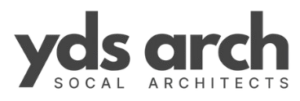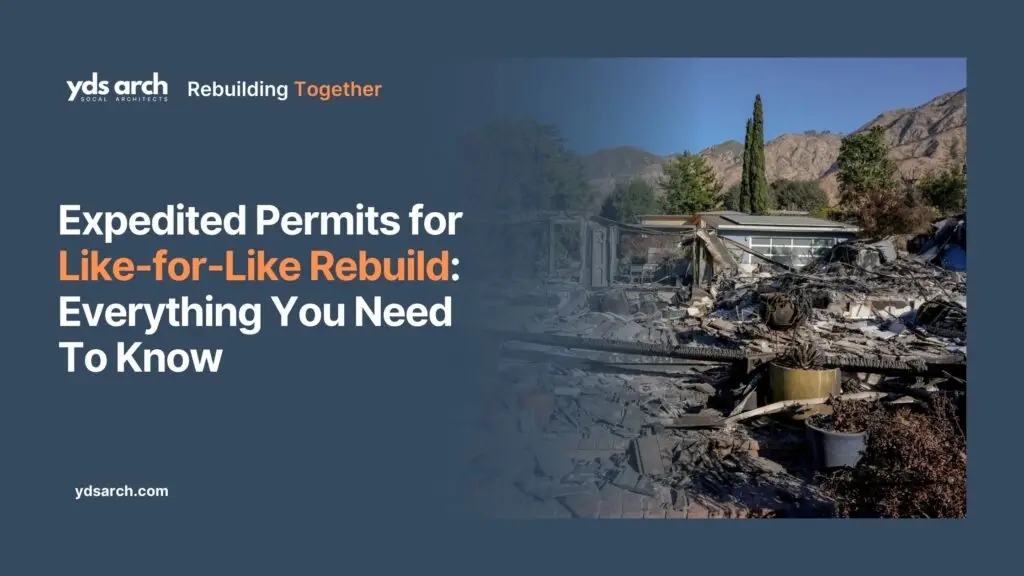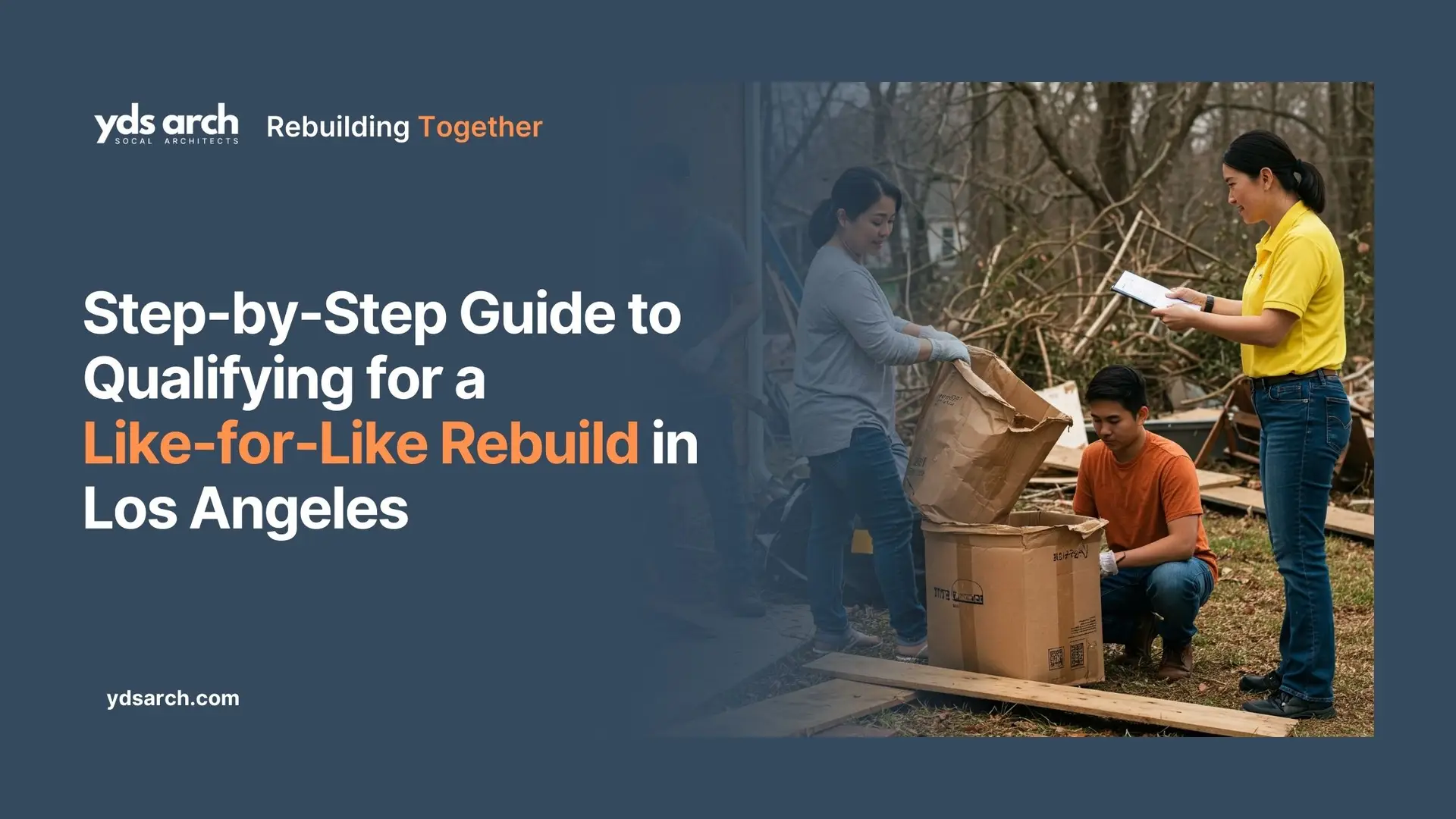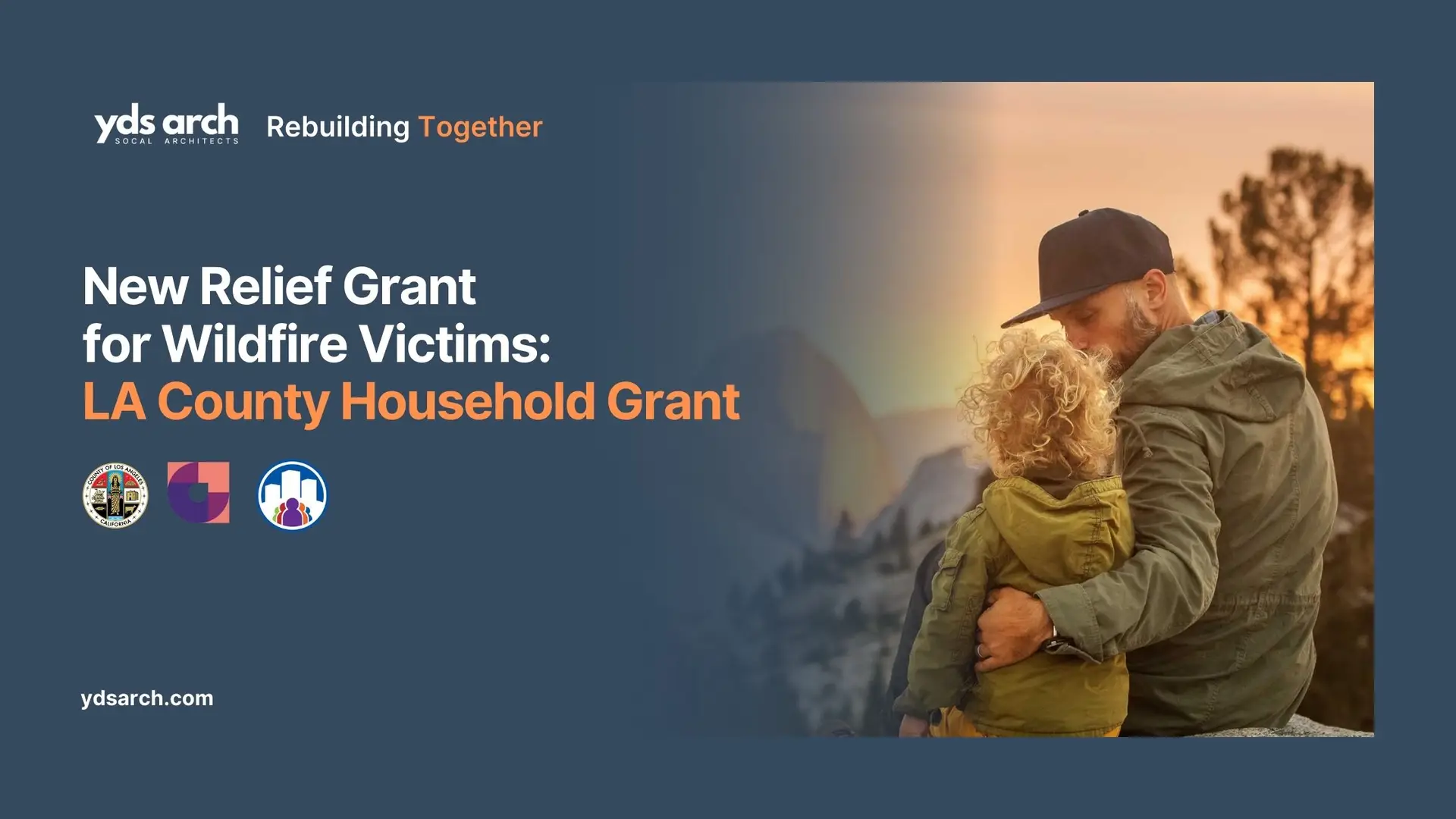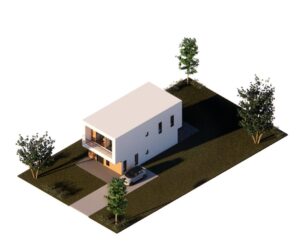In the wake of the devastating January 2025 Los Angeles wildfires, thousands of families are now facing the daunting task of rebuilding their homes. Local officials have introduced measures to help homeowners rebuild faster by allowing “like-for-like” rebuilds – essentially reconstructing the same house that was lost, with minor updates. Nearly 3,000 houses were destroyed in the Pacific Palisades fire alone, and another 5,700 homes burned in Altadena during the Eaton Fire . For many survivors, a like-for-like rebuild offers the quickest path back home. This guide explains what like-for-like rebuilding means, how it compares to designing a custom new home, and the steps to qualify for Los Angeles County’s expedited permitting process. We’ll also look at real-life examples of homeowners pursuing like-for-like rebuilds after wildfires, and provide a clear call to action for getting professional help to navigate the process.
What Are “Like-for-Like” Rebuilds?
“Like-for-like” rebuilds are projects that reconstruct a destroyed home to the same size, in the same location, and for the same purpose as before (LA County Recovers, 2025) . In other words, you’re rebuilding essentially the same house you lost, rather than designing a brand-new custom structure. The goal is to replace what was there with something very similar. Los Angeles County’s recovery policies define like-for-like rebuilds as those that match the previous home’s square footage and footprint (with only slight variations allowed) . This approach has big advantages for wildfire survivors: faster permitting review and approval times compared to more complex new construction projects . The intent is to let folks “just rebuild the house that they lost” as quickly and efficiently as possible .
What minor changes are allowed? LA County does permit some flexibility in a like-for-like rebuild. Homeowners can make slight modifications to the prior design, as long as they do not increase the floor area, height, or building footprint by more than 10% . In practice, this means you could, for example, expand a room or add a small office up to 10% larger than before without losing your like-for-like status. It’s even okay to shrink the house or alter the interior layout if you keep the same number of bedrooms and bathrooms as the original home . The key is that the rebuilt home remains roughly equivalent to the one that was destroyed. Because it’s essentially a replacement in-kind, a like-for-like rebuild does not need to comply with current zoning rules or setbacks that might have changed since the original house was built . (This is a huge relief if your old home was in a location or of a size that wouldn’t be allowed under today’s zoning – you can still rebuild it as it was.) However, any new structure must comply with current building codes and safety codes . In wildfire-prone areas, that means the rebuilt house will incorporate modern fire-resistant materials and meet today’s stricter standards, even if it looks the same as the old one. Officials emphasize that even if you rebuild to the same design, the new house will be sturdier and safer thanks to updated codes .

Aerial view of an entire neighborhood in Los Angeles County devastated by wildfire, illustrating the scale of destruction homeowners face in 2025 .
In contrast to a like-for-like rebuild, opting for a custom rebuild means designing a substantially different home – for example, increasing the square footage beyond that 10% allowance, altering the footprint, adding a story, or changing the architectural style significantly. Custom rebuilding gives you freedom to improve or enlarge your home, but it triggers a longer, more complex approval process. You would likely have to follow all current zoning requirements (since you’re no longer under the like-for-like umbrella) and undergo full design reviews with the city/county. Given the urgent need to house wildfire survivors, many are finding that sticking to a like-for-like approach is the fastest way to get their lives back to normal. The next sections will compare like-for-like vs. custom rebuilds in detail, and then walk through how to pursue the like-for-like route.
Like-for-Like vs. Custom Home Rebuilds
Rebuilding your home after a wildfire can take two general paths: rebuilding the same house you had (with minor tweaks), or designing an entirely new house. This decision has major impacts on how long it takes to rebuild, how much it will cost, and how easy or difficult the permitting process will be. Let’s break down the differences in timelines, costs, and permitting ease between like-for-like rebuilds and custom rebuilds.
Timeline: Fast-Track Recovery vs. Longer Delays
One of the biggest reasons many wildfire survivors choose a like-for-like rebuild is speed. Local authorities have set up expedited permitting specifically for homeowners who are rebuilding essentially the same structure they lost. If you go this route, the permitting timeline is dramatically shorter. For example, Los Angeles County has committed to accelerated plan reviews for like-for-like projects – initial site plan approval through Regional Planning can happen in as little as two weeks , and building plan check reviews are promised within 10 business days for the first review (and 5 days for rechecks) . In practical terms, a homeowner rebuilding an identical house could obtain full permits in a matter of a few months. Indeed, one local construction expert noted that with the County’s expedited process, fire victims rebuilding an identical structure were seeing permit wait times of around 2–3 months, whereas homeowners who made modifications (like adding square footage or new features) faced standard processing times of 4–6 months . In short, sticking to a like-for-like plan can cut your permit timeline in half.
By contrast, a custom rebuild usually means a longer road. Designing a bigger or significantly different house triggers more reviews – you’ll lose the like-for-like fast track and enter the normal queue. Before the recent wildfire disaster, the median time to get a permit for a single-family home in Los Angeles was nearly eight months . After a major fire, officials still pledge to expedite all rebuilds as much as possible, but if your project isn’t like-for-like, it won’t be as streamlined. You may need additional approvals (such as planning commission hearings for design changes or variances), which can add many months. A look at the 2018 Woolsey Fire recovery in Malibu is telling: more than 75% of homeowners opted for like-for-like rebuilds (same footprint, at most 10% larger) to take advantage of the accelerated path, and to “stray from this accelerated option is to incur thousands in additional fees [and] add 12 to 18 months in wait time” . In other words, those who tried to significantly redesign or enlarge their homes often saw their rebuilding timeline extend by a year or more . If your priority is getting back in your home as soon as possible, like-for-like clearly wins on timeline.
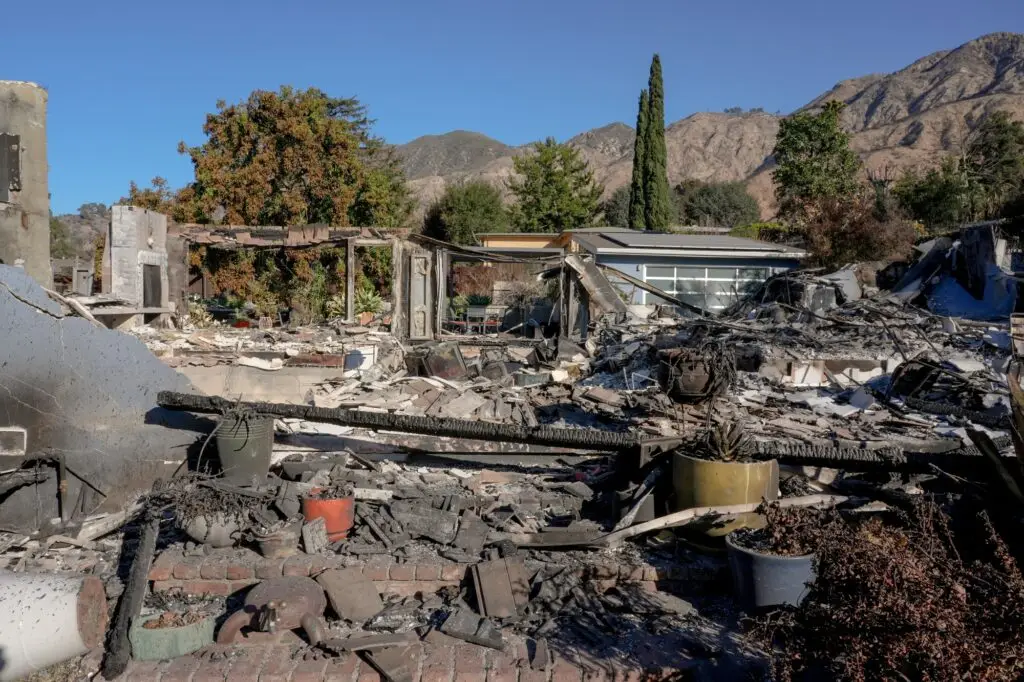
It’s worth noting that even with fast-tracked permits, the overall rebuilding process still takes time – debris removal, permitting, and actual construction can span 12–24 months from start to finish in many cases . But choosing a like-for-like rebuild shaves off considerable delay in the approval stage, allowing you to start construction sooner. As one Altadena homeowner said while weighing options, “We just want to move forward as quickly as possible” – a sentiment shared by many wildfire survivors eager to break ground on their new home without unnecessary holdups.
Cost Considerations: Budget Certainty vs. Upgrades and Overruns
Rebuilding a home in Southern California is never inexpensive, but keeping your new home similar to the old one can help control costs in a few ways. With a like-for-like rebuild, you often can reuse previous plans or at least avoid the need for extensive new architectural design work – this can save on design fees. More importantly, by not expanding the home’s size or dramatically changing its design, you reduce the risk of “scope creep” and expensive upgrades that bust the budget. A basic reconstruction in the Los Angeles area is still likely to cost on the order of $300–$400 per square foot (and high-end finishes can push that above $500 per square foot) , but at least you are rebuilding something of the same scale that your insurance was meant to cover. Homeowners who choose to add custom features or extra footage must be prepared to cover those additional costs – which insurance may not fully fund – leading to potential shortfalls.
It’s also common that when people start redesigning a new dream home, they inadvertently drive up costs. Some wildfire survivors who modified their original plans experienced skyrocketing construction expenses and delays, whereas those who stuck closer to the original footprint emerged much more financially victorious . The Malibu example mentioned earlier is telling: deviating from like-for-like not only added time, but also “thousands in additional fees” for permits, consultants, and reviews . Those extra fees are essentially money that homeowners sticking to like-for-like get to keep for actual construction or upgrades that matter to them.
That said, even a like-for-like rebuild isn’t “cheap” – and it’s critical to recognize that modern building codes will require certain improvements that can add cost. All rebuilds in fire-prone areas must comply with California’s Wildland-Urban Interface (WUI) standards and latest fire codes . This means your new home will need fire-resistant materials (Class A fire-rated roofing, ember-resistant attic vents, non-combustible siding in some cases, dual-pane windows, etc.), which can be pricier than what was on your old house. Labor and material costs have also risen with demand. As one contractor explained, upgraded fire-safe construction and permit/inspection fees can add tens of thousands of dollars on top of base building costs . So, while like-for-like saves money by avoiding major design changes and delays, you should still budget for code-required upgrades and general construction inflation. The good news is that many insurance policies include Ordinance and Law coverage or extended replacement cost options to help cover code upgrades – check your policy to see if new architectural plans or code improvements are funded . If your policy only covers a like-for-like rebuild of the original specs, then choosing a simple rebuild may be the only way to avoid paying out of pocket for enhancements.
In summary, a like-for-like rebuild tends to offer more budget certainty. You’re replacing what you had, so you have a clearer target for costs and insurance coverage. A custom rebuild can fulfill new desires but often comes with higher costs, both in the construction itself and in the process (design fees, permitting fees, financing costs during a longer build, and so on). The decision might come down to your personal financial situation and how underinsured or well-insured you are. Many Malibu owners after the Woolsey Fire who were underinsured “could neither endure nor afford the task of building a new house from scratch, piece by piece” – which is why the majority chose the like-for-like path. If you have ample resources and a strong desire for a different home, you might accept the extra costs of a custom rebuild. But if you need to get back within a tight budget, like-for-like is generally the safer route.
Permitting and Approval: Streamlined Process vs. Bureaucratic Hurdles
When it comes to navigating permits and red tape, the contrast between a like-for-like rebuild and a custom build is stark. Governments at the city, county, and state level have explicitly streamlined the permitting process for like-for-like rebuilds after the 2025 fires. Los Angeles Mayor Karen Bass issued an executive order to “clear the way to rebuild homes as they were,” establishing one-stop permit centers and waiving many discretionary reviews for homes rebuilt essentially as before . LA County’s recovery initiative similarly fast-tracks permits for like-for-like projects. For instance, Regional Planning will do an initial plan check for like-for-like projects within 2 weeks, since these projects don’t need full zoning scrutiny . The Building and Safety Division and Fire Department coordinate to turn around building plan reviews in as little as 10 business days . In short, the agencies collaborate to give a like-for-like application a swift, over-the-counter style review, understanding that the homeowner is simply trying to replace what was lost.
Another huge advantage is that a like-for-like rebuild bypasses certain reviews and constraints that would otherwise apply. Because the project is rebuilding the same structure, no new environmental review (CEQA) is required and often no planning commission hearing is needed. In the City of Los Angeles, officials have even discussed permit self-certification for rebuilding small homes – allowing licensed architects/engineers to sign off plans for immediate construction – given the urgency . The philosophy is that requiring less bureaucracy for like-for-like rebuilds will help communities recover faster. An LA County official put it this way to fire victims: “We want to help you rebuild like-for-like as close as possible, if not better… If you had a mid-century modern, we want to see that mid-century modern come back. If you had a Craftsman, we want to see that Craftsman come back.” . The message is clear: the county will work with you to approve a faithful replacement of your home.
On the other hand, a custom rebuild (anything beyond that ~10% change or fundamentally different design) faces the normal gauntlet of permitting. This can include full site plan review for compliance with current zoning (which might restrict size, height, or require new setbacks and landscaping), design review or architectural review board approvals (especially if in a coastal zone or a community with aesthetic guidelines), and possibly environmental impact assessments if, say, the new footprint encroaches on sensitive areas. There’s also a risk of triggering the need for variances or conditional use permits if your new design doesn’t conform to what’s allowed on your lot – which means public hearings and uncertainty. In Malibu’s rebuild, those who ventured beyond like-for-like often had to go before the Planning Commission, where projects could be rejected or sent back to the drawing board . One Malibu couple invested over $1 million in designing a very different, larger home and endured intense scrutiny – their plan was barely approved by one vote in a planning commission meeting . Such hurdles are not only stressful but can derail your rebuilding timeline if approvals are denied or appealed.
To put it simply, permitting a like-for-like rebuild is a comparatively smooth ride on a well-defined fast track, whereas permitting a custom rebuild is a longer journey through the usual channels. LA County has even set up dedicated “One-Stop” rebuild centers to guide like-for-like applicants through the process, with all relevant departments (planning, building, fire, public health, etc.) present to resolve issues quickly . Homeowners choosing like-for-like will find a cooperative regulatory environment with clear checklists, whereas those opting for something new must be prepared for the full extent of reviews and potential roadblocks that any new construction project faces.
Given these comparisons, it’s not surprising that the vast majority of wildfire survivors are leaning toward like-for-like rebuilds to get back home faster and with less paperwork. As you consider your own rebuild, keep these trade-offs in mind. Next, we’ll go step-by-step through how to pursue a like-for-like rebuild in Los Angeles County, including how to qualify and take advantage of the expedited permitting process.
Rebuild Faster and Smarter: Consult YDS Architects for Expert Guidance
Rebuilding your home – especially under the pressure of recovering from a wildfire – is not a journey you need to take alone. One of the best decisions you can make is to engage experienced professionals who understand the permitting process and can translate your like-for-like vision into reality. YDS Architects is a firm with deep expertise in post-disaster home rebuilding, and they are ready to help homeowners like you navigate every step of the process. From day one, YDS can assist in evaluating your like-for-like eligibility, retrieving or recreating your original home plans, and suggesting smart adjustments that stay within the 10% rule while improving safety and sustainability.
The road to rebuilding is filled with paperwork, codes, and coordination – having an architectural team that knows the expedited permit system in LA County can save you countless hours and headaches. YDS Architects can prepare the complete set of plans and documentation tailored for LA County’s fast-track review, ensuring that your submittals check all the boxes for a like-for-like rebuild . They will work closely with plan checkers and even attend one-stop center appointments on your behalf to iron out any technical concerns. With professionals by your side, you are far less likely to hit snags or rejections – YDS will make sure your designs meet the latest building codes (for fire, structural, energy, etc.) while still capturing the spirit of the home you lost. This means you get the best of both worlds: a home that feels like “yours” and passes inspections with flying colors.
Time is of the essence after a wildfire. Every week saved in permitting is a week sooner you can start construction and move back home. By consulting YDS Architects early in your rebuild planning, you can expedite the timeline and avoid costly mistakes. Their familiarity with LA County’s requirements, from debris removal forms to the final occupancy certificate, will keep your project on the fast track. YDS can also coordinate with structural engineers, contractors, and other professionals to deliver a seamless process from concept to groundbreaking to completion. Many families struggle trying to act as their own project managers post-fire – instead, let an expert guide you so you can focus on your family’s recovery.
Don’t wait to get started on rebuilding. The sooner you have a solid plan and a knowledgeable team, the sooner you’ll be watching your new walls go up on the very spot where you’ll create new memories. Contact YDS Architects for a consultation and take the first concrete step toward reclaiming your home and life. Whether you need help navigating LA County’s permit portal, optimizing your design to qualify as like-for-like, or just want peace of mind that nothing is overlooked, YDS is here to support you. Rebuilding together with the right experts means you can return home faster – and build back better – after the wildfire. Your homecoming is on the horizon, and with YDS Architects steering the process, you’ll get there with confidence and speed. Let’s rebuild your home, like-for-like, and get you and your community on the road to recovery.
